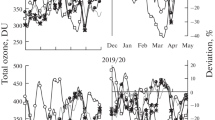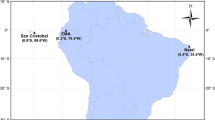Abstract—
In winter–spring of 2019–2020 and 2010–2011 the strongest ozone anomalies in the Arctic in the entire satellite era were observed. They were due to extraordinarily strong and long-lasting stratospheric polar vortices, entailing unprecedented chemical ozone destruction. The analysis of the TEMIS data indicates that the relative total ozone content (TOC) deviations from the multiyear (2003–2019 except 2011) average were 37–44% in 2011 and 45–55% in 2020 at Arctic sites; and 27–36% in 2011 and 27–32% in 2020 at subarctic latitudes. Based on Aura MLS data, the minimal temperatures over the Arctic were 8–12% below normal in 2011 and 8–13% below normal in 2020. The ozone concentration for Alert station dropped to 23% of the multiyear average at the altitude of 20 km on March 22, 2011, and to 6% at the altitude ~19 km on April 15, 2020. A detailed correlation analysis showed that deviations in concentrations of water vapor and ozone, water vapor and temperature, and ozone and temperature from multiyear averages correlate stronger in 2020 than 2011. The correlations decrease toward the vortex periphery owing to the exchange of air masses between the Arctic and middle latitudes, until becoming weakly significant outside the Arctic circle.


Similar content being viewed by others
REFERENCES
H. E. Rieder and L. M. Polvani, “Are recent arctic ozone losses caused by increasing greenhouse gases?,” Geophys. Rev. Lett. 40, 4437–4441 (2013). https://doi.org/10.1002/grl.50835
M. Rex, R. J. Salawitch, P. Gathen, N. R. P. Harris, M. P. Chipperfield, and B. Naujokat, “Arctic ozone loss and climate change,” Geophys. Rev. Lett. 31, L04116 (2004). https://doi.org/10.1029/2003GL018844
M. Rex, R. J. Salawitch, H. Deckelmann, P. Gathen, N. R. P. Harris, M. P. Chipperfield, B. Naujokat, E. Reimer, M. Allaart, S. B. Andersen, R. Bevilacqua, G. O. Braathen, H. Claude, J. Davies, H. De Backer, H. Dier, V. Dorokhov, H. Fast, M. Gerding, S. Godin-Beekmann, K. Hoppel, B. Johnson, E. Kyro, Z. Litynska, D. Moore, H. Nakane, M. C. Parrondo, A. D. Risley Jr., P. Skrivankova, R. Stubi, P. Viatte, V. Yushkov, and C. Zerefos, “Arctic winter 2005: Implications for stratospheric ozone loss and climate change,” Geophys. Rev. Lett. 33, L23808 (2006). https://doi.org/10.1029/2006GL026731
D. Hu, Z. Guan, W. Tian, and R. Ren, “Recent strengthening of the stratospheric Arctic vortex response to warming in the Central North Pacific,” Nat. Commun, No. 9, 1697 (2018). https://doi.org/10.1038/s41467-018-04138-3
M. Weber, C. Arosio, W. Feng, S. S. Dhomse, M. P. Chipperfield, A. Meier, J. P. Burrows, K. Eichmann, A. Richter, and A. Rozanov, “The unusual stratospheric Arctic winter 2019/20: Chemical ozone loss from satellite observations and TOMCAT chemical transport model,” J. Geophys. Res.: Atmos. 126, e2020JD034386 (2021). https://doi.org/10.1029/2020JD034386
I. Wohltmann, P. Gathen, R. Lehmann, M. Maturilli, H. Deckelmann, G. L. Manney, J. Davies, D. Tarasick, N. Jepsen, R. Kivi, N. Lyall, and M. Re, “Near-complete local reduction of Arctic stratospheric ozone by severe chemical loss in spring 2020,” Geophys. Rev. Lett. 47, e2020GL089547 (2020). https://doi.org/10.1029/2020GL089547
J. Kuttippurath, W. Feng, R. Muller, P. Kumar, S. Raj, G. P. Gopikrishnan, and R. Roy, “Exceptional loss in ozone in the Arctic winter/spring of 2019/2020,” Atmos. Chem. Phys. 21, 14019–14037 (2021). https://doi.org/10.5194/acp-21-14019-2021
O. E. Bazhenov, A. A. Nevzorov, A. V. Nevzorov, S. I. Dolgii, and A. P. Makeev, “Disturbance of the stratosphere over Tomsk prior to the 2018 major sudden stratospheric warming: Effect of ClO dimer cycle,” Opt. Mem. Neural Networks 30 (2), 146–156 (2021). https://doi.org/10.3103/S1060992X21020065
J. Rao and C. I. Garfinkel, “Arctic ozone loss in March 2020 and its seasonal prediction in CFSv2: A comparative study with the 1997 and 2011 cases,” J. Geophys. Res.: Atmos. 125, e2020JD033524 (2020). https://doi.org/10.1029/2020JD033524
R. Van der A, “Tropospheric emission monitoring internet service,” in Abstr. of the EGU General Assembly, Vienna, Austria, May 2–7, 2010.
G. L. Manney, N. J. Livesey, M. L. Santee, L. Froidevaux, A. Lambert, Z. D. Lawrence, L. F. Millan, J. L. Neu, W. G. Read, M. J. Schwartz, and R. A. Fuller, “Record low Arctic stratospheric ozone in 2020: MLS observations of chemical processes and comparisons with previous extreme winters,” Geophys. Rev. Lett. 47 (2020). https://doi.org/10.1029/2020GL089063
N. Livesey, W. Read, L. Froidevaux, A. Lambert, M. Santee, M. Schwartz, L. Millan, R. Jarnot, P. Wagner, D. Hurst, K. Walker, P. Sheese, and G. Nedoluha, “Investigation and amelioration of long-term instrumental drifts in water vapor and nitrous oxide measurements from the aura microwave limb sounder MLS and their implications for studies of variability and trends,” Atmos. Chem. Phys. 21, 15409–15430 (2021). https://doi.org/10.5194/acp-21-15409-2021
O. E. Bazhenov, “Ozone anomaly during winter-spring 2019-2020 in the Arctic and over the north of Eurasia using satellite (Aura MLS/OMI) observations,” Atmos. Ocean. Opt. 4 (6), 653–658 (2021). https://doi.org/10.1134/S102485602106004X
A. Inness, S. Chabrillat, J. Flemming, V. Huijnen, B. Langenrock, J. Nicolas, I. Polichtchouk, and M. Razinger, “Exceptionally low Arctic stratospheric ozone in spring 2020 as seen in the CAMS reanalysis,” J. Geophys. Res.: Atmos. 125 (23), e2020JD033563 (2020). https://doi.org/10.1029/2020JD033563
S. Solomon, “Stratospheric ozone depletion: A review of concepts and history,” Rev. Geophys. 37 (3), 275–316 (1999). https://doi.org/10.1029/1999RG900008
O. E. Bazhenov, “Increased humidity in the stratosphere as a possible factor of ozone destruction in the Arctic during the spring 2011 using Aura MLS observations,” Int. J. Remote Sens. 40 (9), 3448–3460 (2019). https://doi.org/10.1080/01431161.2018.1547449
S. P. Smyshlyaev, P. N. Vargin, and M. A. Motsakov, “Numerical modeling of ozone loss in the exceptional arctic stratosphere winter-spring of 2020,” Atmosphere 12 (11), 1470 (2021).
A. N. Luk’yanov, P. N. Vargin, and V. A. Yushkov, “Lagrange studies of anomalously stable arctic stratospheric vortex observed in winter 2019–2020,” Izv., Atmos. Ocean. Phys. 57 (3), 247–253 (2021).
N. D. Tsvetkova, P. N. Vargin, A. N. Luk’yanov, B. M. Kiryushov, V. A. Yushkov, and V. U. Khattatov, “Studying chemical ozone depletion and dynamic processes in the Arctic stratosphere in the winter of 2019/2020,” Meteorol. Gidrol., No. 9, 70–83 (2021). https://doi.org/10.52002/0130-2906-2021-9-70-83
P. Gathen, R. Kivi, I. Wohltmann, R. Salawitch, and M. Rex, “Climate change favours large seasonal loss of Arctic ozone,” Nat. Commun, No. 12, 3886 (2021). https://doi.org/10.1038/s41467-021-24089-6
P. N. Vargin, S. V. Kostrykin, E. M. Volodin, A. I. Pogoreltsev, and K. Wei, “Arctic stratosphere circulation changes in the 21st century in simulations of INM CM5,” Atmosphere 13 (1), 25 (2022). https://doi.org/10.3390/atmos13010025
ACKNOWLEDGMENTS
TOC measurements from Geophysical Observatory in the Institute of Monitoring of Climatic and Ecological Systems, Siberian Branch, Russian Academy of Sciences, used in this work to calculate the deviations of 2019/2020 and 2010/2011 TOCs from multiyear average, were kindly provided by S.V. Smirnov from the Laboratory of Physics of Climatic Systems.
Funding
This work was supported by the Ministry of Science and Higher Education of the Russian Federation (V.E. Zuev Institute of Atmospheric Optics, Siberian Branch, Russian Academy of Sciences). In our work, we used the instrumentations from the Center for collective use, Atmosphere, under the partial support from Ministry of Science and Higher Education of the Russian Federation (agreement no. 075-15-2021-661).
Author information
Authors and Affiliations
Corresponding author
Ethics declarations
The author declares that he has no conflicts of interest.
Additional information
Translated by O. Bazhenov
Rights and permissions
About this article
Cite this article
Bazhenov, O.E. Ozone Anomalies in the Stratosphere of the Arctic and North Eurasia: Comparison of the 2011 and 2020 Events Using TEMIS and Aura MLS Data. Atmos Ocean Opt 35, 517–523 (2022). https://doi.org/10.1134/S1024856022050086
Received:
Revised:
Accepted:
Published:
Issue Date:
DOI: https://doi.org/10.1134/S1024856022050086




